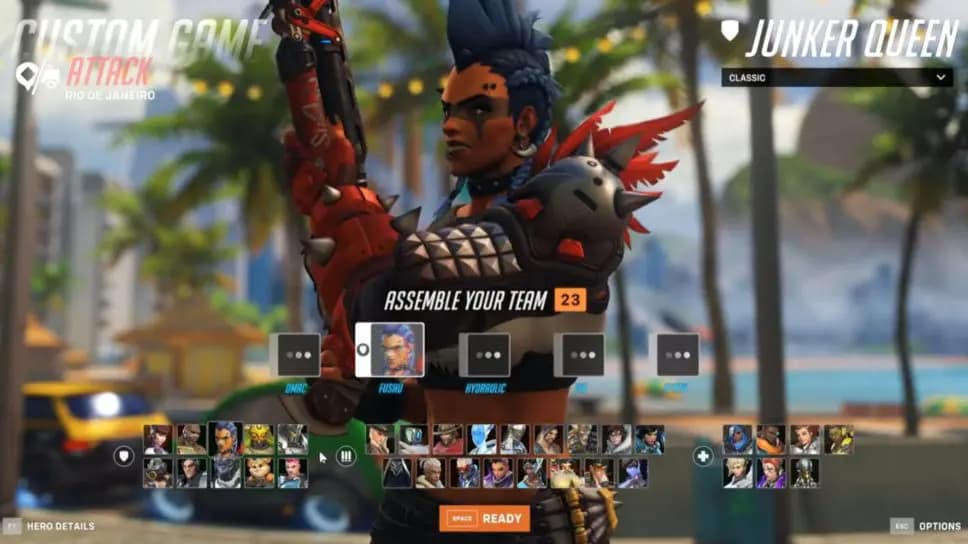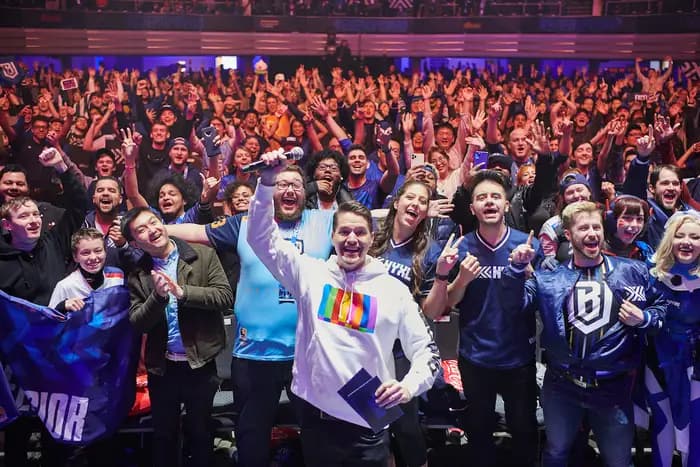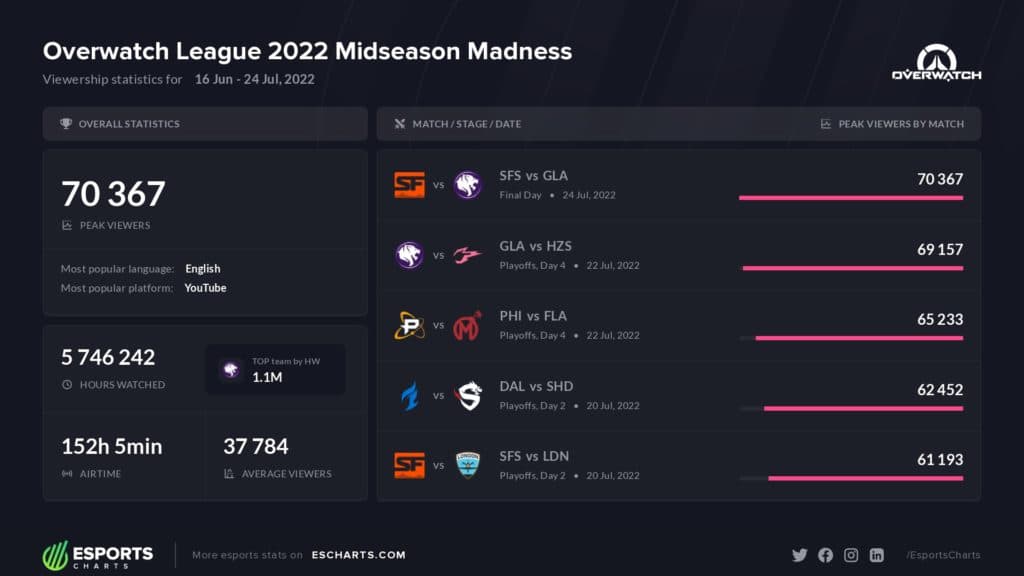A game that has immense potential but has been facing tough times recently.
Overwatch 2 was first announced on November 1, 2019. It was a momentous occasion and the fanbase was excited to see new possibilities open up and a brand new game. Overwatch 1, which is what I guess we will call the first game, was just three years at this point. For a game that was as successful as OW1, it was surprising to hear about Blizzard just announcing its death-date.
Not officially ofcourse. Blizzard wouldn’t do that and also they did not have a public release date for OW2 yet. However, everyone knew, the announcement of OW2 was a ticking bomb for the shelf-life of Overwatch 1.
Overwatch 2: The Overwatch lifeline?
So was Overwatch 2 exactly what the player base needed? What did the player base want? Activision Blizzard felt like it would be a PVP game mode - the big selling point of Overwatch 2. Ofcourse, there are many more additions to Overwatch 2, but none which warrant a brand new title.
Almost every game releases new characters, new maps and changes to existing maps. So when Blizzard launched the OW2 beta on April 26, the community was woefully disappointed. The high expectations of Overwatch 2 beta did not help. There was no PVP mode in the initial beta, so new maps, new heroes, new game modes and some cosmetic changes were all the community saw.
What’s the biggest difference between OW1 and OW2?
That brings us to the question: What is the real big difference between OW1 and OW2?
Here’s what Blizzard had to say.
We are doing things with Overwatch 2 that would be difficult to do without the context of it being a sequel. We are reworking the PvP experience for Overwatch; we’re shifting from a 6v6 team format to a 5v5 team format–it’s removing one of the tanks from the lineup. We’re also introducing role passives for every hero, reworking and modifying a lot of the heroes in the game, [and] removing crowd control abilities from the game.
The problem is the overwhelming majority of the community does not feel the same way. All they see is some cosmetic changes, a few new heroes and some new maps. There’s also new game modes, but this begets the question: Which of these changes could not just have been a part of a update?
A free-to-play game takes a lot of effort to develop and maintain. The Overwatch developers are prepared to keep the ‘new game’ updated. That’s great. But for many fans, the question remains: Why is it OW2?
Players and Money
Players
Overwatch 2 is moving to a free-to-play model. Almost every other big game is free-to-play and the lack of an upfront payment makes onboarding new players much easier. At one point, Overwatch was considered a tier 1 game, some might still say it is one of the top games today. But the declining interest in the game points otherwise.
Overwatch released on May 24, 2016 to much fanfare and the game was a resounding success. Despite being a paid game, Overwatch could still attract millions of users from all over the world. The game’s popularity rose in key markets including North America, Korea and even China.
But the player base growth has not kept up. The interest around Overwatch rose earlier this year when we got a glimpse of how Overwatch 2 looks like. But if we are to take OWL viewership as a measure, the numbers are not encouraging.
Money Money Money
The next big difference is money - specifically game monetization. Overwatch 1 relied heavily on the sale of in-game lootbox sales. But the business model of lootboxes has very much vanished in esports. Various country regulations prohibiting lootboxes fuelled the demise of the concept.
With declining player numbers and lower interest in loot boxes, Blizzard was facing a real challenge of monetizing its vast player base. They could do that in two ways: increasing the player count and providing other in-game currencies and cosmetic sales.
Making the game free-to-play is a big step forward in, hopefully, increasing the playerbase. And changing the sales of cosmetic items in Overwatch 2 was born out of necessity and desire.
Let’s take some examples from other titles: Dota 2, League of Legends,
Some new content: But worth a new game?
If the new content highlighted in Overwatch 2 would be an update to the original game, the community would most likely have cheered on for the developers. But the brand new game had very high expectations partly due to the delays and the tall promises by Activision Blizzard themselves. Instead fans were faced with a game that looked very similar, a change in the day-night cycle for some maps, new heroes, new maps and game modes - nothing truly extraordinary. Nothing that necessitates the need to create a new game.
The exit of Jeff Kaplan, the most popular face in Overwatch meant that the new game seemed slightly more alien to existing players. While personnel changes are very common in video games, we don’t often see one developer be put on such a pedestal as Jeff Kaplan was (even though he probably deserves every bit).
Is it really a new game?

So is it really a new game? Or is it just a remastered old game? There’s still more content to come in Overwatch 2. The PVP mode is something that the developers have high hopes for. After all, Overwatch lores have been exceptionally well-received and the community loves the comics. But it brings us back to the question - Is it really a new game if you add a PVP mode?
After all, there have been games such as Dota 2, League of Legends, CS: GO that have not changed their names or released new versions. All three of these games have completed a decade in existence and will most likely continue for several more years to come. Overwatch released in 2016 and Blizzard announced Overwatch 2 in 2019. Overwatch 1 had barely existed for a few years before Blizzard sounded it’s death sentence.
Big Problems for Overwatch
Related articles
The Wait: Oh the frustrating wait!
Overwatch’s decline in viewership and potentially player base is influenced by multiple factors. One of the key reasons for the lack of interest in Blizzard’s ‘new’ FPS game is the frustratingly long wait. And it’s not the first time either.
Back in 2018, before the start of the Overwatch League, there was a famine of esports tournaments in Overwatch. This was, many would say, the lost golden era of Overwatch. After a bumper year of esports tournaments where esports tournaments in Korea brought teams from all over the world, most teams were left waiting for Blizzard’s announcement on the future of Overwatch esports.
For many Overwatch fans, this period - before Overwatch 2’s official release - is reminiscent of the lsot golden era. Activision Blizzard has spent several years making the fanbase waiting for Overwatch 2. Meanwhile, the base game, or Overwatch 1 as we may call it, has a noticeable lack of content. In a world, where new games are coming out every few years, and Blizzard has a brand new competitor in Valorant, the lack of content is concerning for the fanbase.
It’s difficult to say which game is more popular now - Valorant or Overwatch. But the growth direction seem to be going in opposite directions.
Where's the new content?
Overwatch 2 will release with 3 new heroes, new maps and a new game mode. That sounds great, but over the past few years, there has been a noticeable lack of new content in Overwatch 1. Players have been frustrated with the meta and the lack of content. For a game like Overwatch, which relies less on aim and more on abilities and positioning, the only way to achieve game balance is via releasing more and more heroes.
Traditional MOBAs like League of Legends and Dota 2 have hundreds of heroes. Despite the small tectonic shifts in the meta, the games are still much more balanced compared to Overwatch. Overwatch 1 will have a total of 31 heroes, Activision Blizzard has announced.
So now fans are awaiting the release of more heroes in Overwatch. Not only does new content help balance the game, but it also creates excitement and anticipation for players.
But wait… what about Overwatch League?
Amidst Activision Blizzard’s pivot to Overwatch 2, the bigger question on almost everyone’s mind is - What’s happening to the Overwatch League? Blizzard moved fast after seeing the Overwatch’s tremendous success at release. They announced a global multi-million dollar Overwatch franchised league with home and away matches. Teams would travel across the globle to compete in front of a live audience.
All of this sounds great - it sounded grand at the time. But the franchise buy-ins were the thorn in the side of even some of the most optimistic esports enthusiasts. There was little at the time to justify a $20-25 million buy-in for these franchises. The second year of the League saw these numbers increase even further. All the time, there was no clear path to monetization in an industry that strongly relies on sponsorships and VC money.
Teams running scared?

A GGRecon report by Sascha ‘Yiska’ Heinisch suggests that one of the franchises, Washington Justice, is trying to sell its players after a loss of trust in the OWL Finances. Crucial to note that this year, the Overwatch League has failed to secure any new sponsors, still rocking Upper Deck and TeamSpeak as the official sponsors.
Overwatch League’s exclusive streaming rights with YouTube Gaming is up for renewal at the end of the year. This is the Overwatch League’s biggest source of income and any new deal will be seen as an indicator of the League’s growth or decline. YouTube Gaming’s deal with the Overwatch League was valued at $160 million for two years. However, the deal involved a lot more than just Overwatch bringing Call of Duty, Overwatch and Hearthstone under the YouTube Gaming umbrella. The deal also had something for Google Cloud which has been providing cloud computing services to Activision Blizzard.
So two years later, as we head towards the end of the Blizzard-YT deal, reports of OWL teams losing confidence in the League’s finances is not a good sign.
Lack of optimal planning
The Overwatch League adopted a ‘Home and Away’ format. The League took inspiration from physical sports leagues such as the NFL, NBA and more. Teams are always traveling across the country to play in Home and Away matches. These games are often attended by thousands of fans who contribute to the teams’ home stadium revenues. There’s also merchandising, media broadcast rights and more sources that contribute to their income.
We are now in the fifth season of the Overwatch League and the original vision still does not look likely. In fact, the COVID pandemic provided a relief to teams who did not go for the original ‘Home and Away’ format.
This Reddit post highlights the stark contrast in this year’s Midseason Madness setup versus some of the glory days in Overwatch history. Obviously, it’s unfair to do a direct comparison. A lot has transpired in the last 5-6 years. We’ve had a global pandemic that still refuses to die down. There are travel restrictions across the world and a global economy staring at a slowdown.
But even before the pandemic, things were not looking good for the original vision. An Overwatch team does not comprise of just the six active players on the roster. There are usually more than six players signed to a single team. There’s support staff including physiologists, chefs, psychologists, the coaching staff and more. The cost of moving all personnel equipment, often across the world from the West to East and back, was simply too much for teams who are still trying to figure out how to monetize esports.
A disconnected roadmap … with lack of communication
The lack of communication rounds this article back to the original game development and ties it with the esports side.
The main reason for the community’s disappointment with Blizzard has been the notorious lack of communication. And when Blizzard revealed more details about Overwatch 2, it was only about new heroes, a few new maps and a new game mode. They made no mention of PVP content, which is the key selling point of Overwatch 2.
Communication is crucial for any developer’s relationship with their community. Hopefully, Activision Blizzard will bring in more ‘meaningful communication’ which will help players understand better.
What’s next for the Overwatch League?

So the raises the question - What’s next for the Overwatch League? The Overwatch League does not have the same lineup of sponsors, it doesn’t evoke the same excitement even within the diehard optimists, it feels like the opportunity that’s passed us by.
The Overwatch League needs a change in its model. It might come from a remagination of the original globe-trotting franchise teams or it could be a refinancing of franchise costs. There are indicators, the Overwatch League franchises are already looking to cut costs and are having trouble sticking to the original schedule. The reasons are clear for all to see. The Overwatch League has seen declining viewership, less media coverage and reduced interest. The player base also does not seem to be growing at a good pace, a fact that Activision Blizzard would certainly have advertised.
All eyes are on Overwatch 2’s official release in October now. It has the potential to revive the game’s charm - because don’t get me wrong - Overwatch is one of the best games out there. It’s fun to play but not as great to watch. Let’s hope Activision Blizzard charms millions of players yet again, this time with a free-to-play Overwatch 2.
Stay tuned to esports.gg for the latest Overwatch news and updates.

